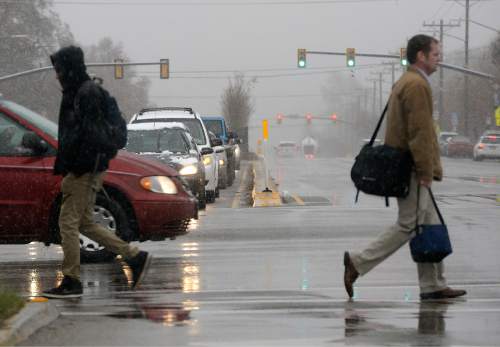This is an archived article that was published on sltrib.com in 2016, and information in the article may be outdated. It is provided only for personal research purposes and may not be reprinted.
Utah's mountains are currently sporting a roughly average snowpack — welcome news to many after four years of drought — but other factors suggest much of that snow won't make it into reservoirs this spring.
Most of Utah's snowpack is in the range of 90-100 percent of normal; the mountains surrounding Salt Lake City and Provo are among the driest, at 90 percent. Southeastern Utah is still holding up better than the rest of the state, with snowpack at 111 percent of normal.
But while mountain snow accumulation looks good, spring runoff may disappoint, said Brian McInerney, a hydrologist with the National Weather Service in Salt Lake City.
"The problem is we have an average snowpack on a very dry soil layer," he said. "... The runoff forecast is below average because of the dry soils."
McInerney said there are basically three factors or stages that lead up to the accumulation of water in Utah's reservoirs. Soil moisture levels are determined in the fall — when fall's precipitation comes up short, it leaves the soil thirsty and capable of soaking up a greater portion of the following spring's runoff.
The second stage, snow accumulation, obviously occurs throughout the winter. This past winter had a good start in December and January, but February's dry, warm weather caused a lot of that snow to melt prematurely. March helped to replenish what was lost, but didn't bring enough to make up for the soil moisture deficit left by last fall's dry weather.
This spring will determine how much of this year's runoff — the snowmelt that isn't absorbed directly into Utah's thirsty soils — actually ends up in reservoirs.
If the weather stays cool and wet this month and next, McInerney said, this summer's crops, gardens and lawns will fare better. But a warm, sunny weather trend will increase the amount of runoff that is lost to evaporation.
The National Weather Service's Climate Prediction Center currently forecasts above-average temperatures for April, as well as above-average precipitation. The center expects that trend to continue through June.
Even though the forecast calls for a light runoff season, McInerney warned that streams and rivers will still see periods of high flow. If you're around running water this spring, he said, you still need to be aware of your surroundings and keep a close eye on kids.
"If you fall into a mountain stream at runoff season, you will be hypothermic in about two minutes," he said. "Every year people drown and die in runoff."
Twitter: @EmaPen



